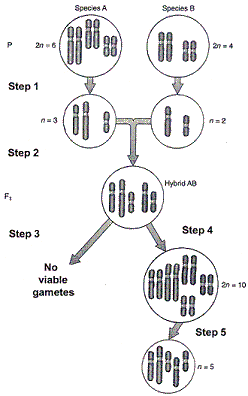A plant sustains pathogen-induced damage to one of its cell walls. A gene-for-gene response soon follows and the tissue surrounding the injury soon dies. Which signaling molecules facilitated this response?
A. Gibberellins
B. Ethylene
C. Oligosaccharins
D. Auxins
E. Abscisic acid
Answer: C
You might also like to view...
Successful cotransformation in the yeast two-hybrid system will result in the binding of proteins produced by each yeast expression vector. These fusion proteins function by
A) binding to the lacZ operator, preventing transcription. B) binding to RNA polymerase, preventing transcription. C) binding to the lacZ repressor, enabling transcription. D) binding to the lacZ upstream activator sequence, enabling transcription. E) changing color in the presence of X-gal.
The end result of the process in Figure 20-1 is:

a. sympatric speciation.
b. allopolyploidy.
c. hybridization.
d. rapid speciation.
e. All responses apply
_________ destroys all viable organisms including viruses.
A) Sterilization B) Antiseptic use C) Disinfection D) Sanitization
Most Gram-positive bacterial cells exhibit which of the following characteristics?
A) Thick layer of peptidoglycan without teichoic acids and large periplasmic space B) Thick layer of peptidoglycan with teichoic acids and small periplasmic space C) Thin layer of peptidoglycan without teichoic acids and large periplasmic space D) Thin layer of peptidoglycan with techoic acids and a small periplasmic space